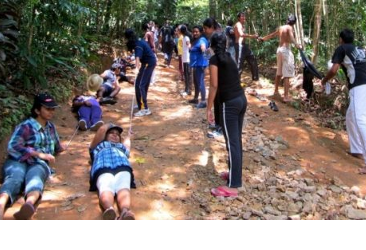In pursuit of “team work”!
By Indrajith Karunarathna
As employees of John Keells Group, we are blessed with the opportunity to get ourselves involved in group activities. The ultimate aspiration is to confront and conquer all challenges and obstacles with the prime intention of achieving the desired and preferred goal.
 This ‘group’ performance is finally called “team spirit” which inspires us to accomplish goals way beyond our imagination, providing us – at the same time – lessons for life. This was put to the test on my recent journey to Kithulgala for out bound training (OBT).
This ‘group’ performance is finally called “team spirit” which inspires us to accomplish goals way beyond our imagination, providing us – at the same time – lessons for life. This was put to the test on my recent journey to Kithulgala for out bound training (OBT).
In this journey I got to know what team spirit was all about! In every sport there are teams comprising colourful or outstanding players who are not honoured individually; instead, the team is recognised as a whole. Any tendency by any team member to lower their commitment would eventually result in having to bid goodbye to victory. Let me illustrate some of the key lessons I learned that might help you at your workplace.
The entire family of InfoMate (a Group Company of John Keells Group) was divided into four teams. The four teams were assigned five major activities out of which a winning squad was selected. “Proper Prior Preparation Prevents Poor Performance” (or “6Ps”) was the main theme for the entire programme. This theme was tested at the end of each activity.
The first activity was to form the longest line possible by stretching members – without using external gear. This required imagination as well as proper planning.
In evaluating team performance, the indicators used were the correct course of action, vision, strategic decision-making, proper guidance, and utilisation of scarce resources. Overall, this enabled the teams to achieve targets under ‘harsh’ conditions.
The second activity consisted of providing written answers to a pre-set question paper based on numeric riddles, general IQ, critical thinking ability, social awareness, and management skills. Thus, each team leader was to complete these questions by exploiting individual knowledge and skills of each team member. This activity emphasised on a person’s ability to harness the skills of others to accomplish the maximum within a limited time.
The next activity utilised the innovation skills and creativity amongst the participants! Teams had to pick – within a specific time period – some items scattered on the floor beyond a marked line, without touching the said line.
Although it was not an impossible task, it promoted creative thinking to achieve targets. In addition, it highlighted the need for strategic decision making in a dynamic environment. At this point I realised the high level of creativity among my colleagues: hilarious, but creative!
The fourth activity required all teams to tie a bottle with different strings to manoeuvre the bottle in such a way that they empty the contents in this bottle to another vessel. This tricky exercise called for collaboration to accomplish it successfully. A single blunder by one person would spell doom for the entire team!
As the final segment of the programme, each team was given a PVC tube sealed at one end with several holes on its side. The mission was to fill the tube with water to enable a plastic ball inside the tube to rise to the top. Members were allowed to plug the holes with whatever they can find to prevent seepage of water. This activity too stressed the importance of participatory and collaborative work to achieve a goal.
In my opinion, “true teamwork” is the rarest, most thrilling, and productive

human activity. Every business should harness this incredible resource. Nevertheless, achieving such levels of motivation and spirit is not always easy. A team is not just a group of individuals who toil at the same task. A real team is made up of people who may be unequal in experience or education, but who are equal in their commitment and keenness to work together and make things happen.
Maybe it’s just me, but after returning to work the next day, I felt we had developed a stronger bond with each other. Every activity was an opportunity to discover our hidden capabilities, ‘forgotten’ knowledge, and unique strengths – both as a team and as individuals. Isn’t this the ultimate purpose of training?









Leave comment